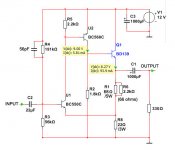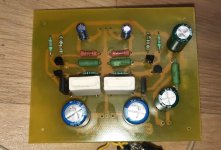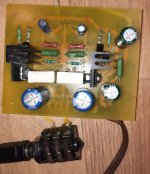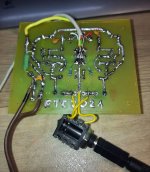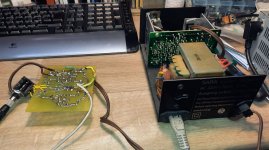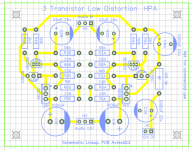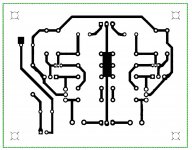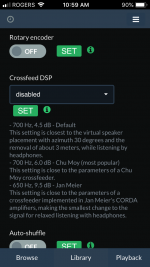Looking forward Avtech23!I might have something interesting on this topic coming next month..
Got the same combination now and I also think its superb together (as far as I can tell with only one proper pair of headphones).My old DAC (a HRT Music Streamer II) is replaced by a Topping E30. Formula3HP is revealing enough to hear differences between the old DAC and the new one. A very good combination.
It is very detailed, smooth and never fatiguing. That´s why I have problems finishing other projects ;-)
I almost bought these headphones (blindly) after reading XRK´s review but they are hard to get in europe and then I am too sensible these days buying headphones I haven´t listened to before. Anyways, looking forward what you have up your sleeve.It's the only one that pairs nicely with my ESS422h headphones.
Although I have several headphone amplifiers, I wanted to hear how a simple Class A amplifier sounds like, without anything special, so I made the schematic from the first post. Below you have the changes I've made, to be able to use what I have in the drawers. I hope the author doesn't mind my modifications, I will also post this article on a Romanian forum, including modifications and source link. I don't use simulating nor PCB making software, so the modification I made are just graphically.
So here's what I've changed:
1. I mounted a 56pF capacitor in the bases of the U1 transistors, otherwise the amp would strongly oscillate on high frequencies. The transistors I use have probably a much higher hFE than the originals used by the author - mine have around 500 - I have enough power even for 300 ohm headphones. It's true that I'm not the type to listen very loud.
2. The resistors in the emitter of BD139 must be higher than 0.6W, so I used some resistors of 3W, respectively 5W, as in the figure.
Pay attention to the power supply used, you must have a stabilized and well filtered source. Initially I used a switching power supply, quite good, but I had an annoying hiss, which did not disappear even when placing a ceramic capacitor of 68nF parallel on the last capacitor filter - this is not included in the diagram, but remained in the assembly after we returned to the linear source - a good quality source, originally purchased for the beautiful box. But he earned his right to remain in the original version.
The wiring, as you can see, was done manually, old school, starting from the drawing of @avtech23. Compared to what is posted there, I used a 13.5V source (it was somehow modified by the former owner, probably for some broadcasting station) and the value of the resistance between the two capacitors was lowered to 6.8 ohms to have 12V on the last filter capacitor.
I recommend this amplifier, at least for your curiosity. I don't think you will regret it. Obviously the wiring can be made much more compact than I did - but I wanted to have more room for maneuver, being a test setup.
I did not make measurements, nor do I think it is necessary for such an assembly, far from the peak of performance for sure - although something simple shouldn't necessarily sound bad.
Now I don't have too much time last, because I am going on vacation, but I invite you to build and measure this amplifier and when I return I will present my results. Compared to the values in the diagram, the voltages measured by me, statically, with the shorted input are higher by about 0.35V, probably due to the transistors with higher hFE.
So here's what I've changed:
1. I mounted a 56pF capacitor in the bases of the U1 transistors, otherwise the amp would strongly oscillate on high frequencies. The transistors I use have probably a much higher hFE than the originals used by the author - mine have around 500 - I have enough power even for 300 ohm headphones. It's true that I'm not the type to listen very loud.
2. The resistors in the emitter of BD139 must be higher than 0.6W, so I used some resistors of 3W, respectively 5W, as in the figure.
Pay attention to the power supply used, you must have a stabilized and well filtered source. Initially I used a switching power supply, quite good, but I had an annoying hiss, which did not disappear even when placing a ceramic capacitor of 68nF parallel on the last capacitor filter - this is not included in the diagram, but remained in the assembly after we returned to the linear source - a good quality source, originally purchased for the beautiful box. But he earned his right to remain in the original version.
The wiring, as you can see, was done manually, old school, starting from the drawing of @avtech23. Compared to what is posted there, I used a 13.5V source (it was somehow modified by the former owner, probably for some broadcasting station) and the value of the resistance between the two capacitors was lowered to 6.8 ohms to have 12V on the last filter capacitor.
I recommend this amplifier, at least for your curiosity. I don't think you will regret it. Obviously the wiring can be made much more compact than I did - but I wanted to have more room for maneuver, being a test setup.
I did not make measurements, nor do I think it is necessary for such an assembly, far from the peak of performance for sure - although something simple shouldn't necessarily sound bad.
Now I don't have too much time last, because I am going on vacation, but I invite you to build and measure this amplifier and when I return I will present my results. Compared to the values in the diagram, the voltages measured by me, statically, with the shorted input are higher by about 0.35V, probably due to the transistors with higher hFE.
Attachments
Yes, you are right, but it was a quick build, I finished the PCB, up and running in a single day. I'm not native in English, so to read the whole topic takes too long. But now I'm encouraged to learn more about this design, even if I was vers skeptical initially.
Thank you for the pointing, I thing I will also order some PCB's in China, to make a better looking project. But this lately, starting from the first days of September.
Looking to post 152 it seems that the oscillation depends on the transistor batch, in my case there was not a solution placing the capacitor to the 2-nd transistor. But also I used a much smaller value...
Thank you for the pointing, I thing I will also order some PCB's in China, to make a better looking project. But this lately, starting from the first days of September.
Looking to post 152 it seems that the oscillation depends on the transistor batch, in my case there was not a solution placing the capacitor to the 2-nd transistor. But also I used a much smaller value...
Last edited:
Good to see another build of this cool little amp.
Important changes from the original schematic were:
2.2uF capacitor not 22uF for input.
Input filter 2k2 into a parallel 220pF and 100k to ground.
This in particular makes a big difference to prevent roll-off of the upper frequencies.
Important changes from the original schematic were:
2.2uF capacitor not 22uF for input.
Input filter 2k2 into a parallel 220pF and 100k to ground.
This in particular makes a big difference to prevent roll-off of the upper frequencies.
Especially with the values Avtech23 suggested it is very well possible to use a switching power supply, as I did. Just try a few if possible, not all are equal. If the switching frequency is high enough you won´t hear hiss or other artefacts. In my case it even was not necessary to use filtering.Initially I used a switching power supply, quite good, but I had an annoying hiss
I use a switching power supply I had laying around for a long time, probably salvaged from an old broken device.
Last edited:
Crossfeed;
Should a crossfeed feature be added to this HA ?
I have the following option via my Moode Audio music server (see pic) but would rather have a switch to enable/disable the crossfeed on the HA itself. Do you guys believe it’s complicated and if not, worth implementing?
Thanks
Eric
Should a crossfeed feature be added to this HA ?
I have the following option via my Moode Audio music server (see pic) but would rather have a switch to enable/disable the crossfeed on the HA itself. Do you guys believe it’s complicated and if not, worth implementing?
Thanks
Eric
Attachments
It is probably a good idea to implement optional crossfeed in headphone amps.
You could use one of these passive little circuits mentioned in this thread which could easily be done on perfboard:
Crossfeed solution
You could use one of these passive little circuits mentioned in this thread which could easily be done on perfboard:
Crossfeed solution
I'm also interested in crossfeed, should we continue in the thread indicated by @joensd? I posted a question there...Maybe not everyone should be interested...I search for a passive sollution, to be kept along with the specified headphones pair, rather than the amplifier...
Music is usually mixed for loudspeakers and so both channels reach your eyes at some point. It can be very different to the headphone listening experiences.If there is a need to use crossfeed, surely something is wrong in the audio chain (signal source, amplification, headphones) or with the physiology of the ear.
It is also possible that there is a somewhat wrong perception preference.
Admittedly, in most recordings you´d be hard pressed to hear differences easily.
There are some recordings where music is recorded such that a certain instrument is only (100%) on one side (in comparison to just mostly being on one side).
These might be more listenable with crossfeed. People report less fatigue on some recordings with crossfeed.
It sure is a very subjective topic.
It is easy enough though to implement it to have the possibilty to try it.
I have a Porta Corda which uses a switch to turn it on.
Some recordings sound more listenable with crossfeed but these are <<1% and I sure could live without it.
("eminence front" from The Who is an example with an "extreme" mix)
Considering that the soundstage of speakers and headphones are quite different I dare (naively) say I can´t agree.And the soundstage is
Picture the extreme recording with bass 100% on the right channel.
With speakers you will hear the bass with both ears nearly at the same SPL but with a delay, so you will be able to "judge the direction it comes from" (its more complicate than that but lets forget about room acoustics for the moment).
With headphones you have the bass on your right ear with full SPL and no bass on the left ear. No direction, no room delay and other effects;
other than what the brain makes from that.
I´m not an expert on the topic. Its very interesting and complicate but in my understanding the sound of normal speaker, dipole speakers and headphones are very different when it comes to soundstage.
This way I´d argue that a "crossfed" headphone experience is nearer to the speaker experience (which is the tool music is usually mixed with).
If you ever listen to a crossfed headphone amp you will also realize that the effect is so minimal you will not hear a difference easily (again: most recordings).
Enter psychoacoustics! That´s really something I want to know more about.
Linkwitz has quite a bit to say on the subject and also compares speakers and headphones:
https://www.linkwitzlab.com/IJAETv2n2a2-Linkwitz-1.pdf
from:
Linkwitz Lab - Loudspeaker Design
Yes, the crossfeed is nearer the loudspeaker experience, at least in some cases, not all, that's why I have my reserve in accepting this trick unconditionally. But for sure "NO" isn't the right answer.
Maybe the better approch could be some sofissticated DSP, I doubt any simple filter or analogic circuit could simulate the speaker experience...but this idea is far more for a 3 transistor amp discussion...one possible answer is a device like Focusrite VRM, a virtual speaker emulation device. But now it's discontinued, I try to imagine the idea didn't sold as well as expected, Focusrite is a great brand and still in production.
Maybe the better approch could be some sofissticated DSP, I doubt any simple filter or analogic circuit could simulate the speaker experience...but this idea is far more for a 3 transistor amp discussion...one possible answer is a device like Focusrite VRM, a virtual speaker emulation device. But now it's discontinued, I try to imagine the idea didn't sold as well as expected, Focusrite is a great brand and still in production.
About the entire spectrum, or a good part of it, of low frequencies placed on a channel is a mistake, no doubt.
It is a little more difficult to have the accuracy offered by listening to headphones in a room with the corresponding speakers. That's why I prefer headphones. It's quite complicated in a room ... I managed to do the best audition at the speakers outside, outdoors. And as we talk about perceptions, subjective in fact, opinions can not be unanimous.
It is a little more difficult to have the accuracy offered by listening to headphones in a room with the corresponding speakers. That's why I prefer headphones. It's quite complicated in a room ... I managed to do the best audition at the speakers outside, outdoors. And as we talk about perceptions, subjective in fact, opinions can not be unanimous.
32 ohm and 2200u gives an fc of 2.2Hz. 14 ohm and 4700u would give 2.4Hz. 3300u gives 3.4Hz.
Would probably need to be careful with turn off thump for 4700u, though 3300u into 38 isn't too bad on my latest one.
I'll try to run the sim this evening and see what it looks like with 14 ohms.
Would probably need to be careful with turn off thump for 4700u, though 3300u into 38 isn't too bad on my latest one.
I'll try to run the sim this evening and see what it looks like with 14 ohms.
- Home
- Amplifiers
- Headphone Systems
- 3 Transistor HP Amplifier with low dist
